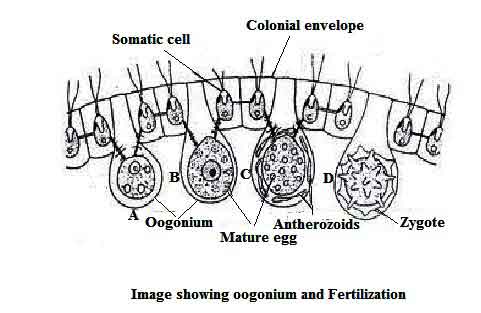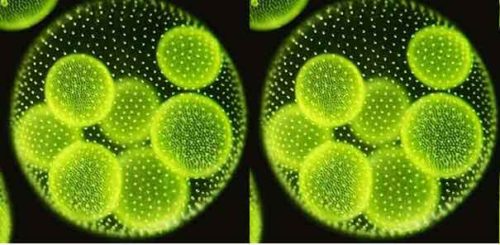Volvox is a common freshwater free-floating chlorophytic green alga that belongs to Volvocaceae family under order Volvocales of division Chlorophyta. They occur in temporary and permanent freshwater tanks, ponds, pools, ditches, etc. There are some 20 freshwater species of Volvox which prefer to live in colonies with up to 60,000 cells by making a gelatinous wall. These colonies have an ovoid or spherical hollow shape which may be larger than a pinhead size. Dutch microscopist Antonie van Leeuwenhoek first reported the Volox colonies in 1700.
The mature Volvox colony contains two separate cell types namely germ cells of the smaller number and numerous flagellated somatic cells. In this case, adult somatic cells have a single layer that contains two flagella which allow the organism to swim in a coordinated fashion in water. The cells have distinct anterior and posterior poles. The anterior pole possesses photosensitive eyespots that make it possible for the colony to move towards the light. The Volvox colonies are asexual which produce daughter colonies within the parent colony. After maturing, the daughter colony comes out from the parent colony.
Each Volvox species are able to make its own food through photosynthesis due to the presence of chlorophyll in its body. During spring, the surface of the water in which Volox occurs looks green. During early summer, the Volox abruptly disappears and it remains in resting zygote condition. Volvox colony appears in the rainy season.
You might also read: Bryophyta: Characteristics and Classification
Characteristics Features of Volvox
- The Volvox cell is single, ovoid or spherical in shape which contains two flagella and it appears like a minute floating ball of a pinhead size.
- The base of the flagella bears single cup-shaped chloroplasts.
- Each individual cell is attached to each other with cytoplasmic strands.
- Each individual cell possesses a red eyespot on its surface.
- Anterior cells of the particular colony of Volvox possess phototactic abilities while the posterior cells perform reproduction.
- The size of the Volvox colony ranges from 100-6000 µm.
- We cannot see the Volvox species with the naked eye due to their microscopic size but few colonies are easily visible because of their big size with 1 mm in diameter.
- Volvox prefers to live in nutrient-rich water bodies such as lakes, pools, canals, ditches, etc.
- Each cell of the Volvox colony produces mucilage which makes the colony distinct or inconspicuous.
- They show the flagellar movement. In this case, the flagella of all the cells of the colony perform simultaneous action by which the entire colony rolls over the surface of the water. Besides these, the eyespot controls the movement of the flagella as they are photoreceptive organs.
- They reproduce both asexually and sexually.
- They can be dioecious or monoecious. In this case, the male colony produces lots of sperm packets while the female colony releases oogamete or ovum.
Systematic Position of Volvox
- Division: Chlorophyta
- Class: Chlorophyceae
- Order: Volvocales
- Family: Volvocaceae
- Genus:Volvox
- Species:Volvox globator, V. minor, V. aureus, V. africanus, V. prolificus
Structure of the Vegetative Body
Volvox occurs in the colony because it is a coenobial form (hollow ball) like a structure. In the young colony, the vegetative cells are similar in size and green in color. Each motile colony (coenobium) is free-swimming and appears as small pinhead like spherical to ovoid shape with hollow mucilaginous mass which consists of numerous small pear-shaped cells arranged in a single layer joined with one another by delicate strands of cytoplasm within the periphery of the gelatinous colonial matrix. The total number of cells in the colony varies from about 500 (Volox aureus) to about 2000 or more (Volvox globate). Each colony develops the following three types of cells:

- Vegetative Cells: These cells are flagellated and vegetative in nature and are unable of giving rise to new colonies. They are involved in locomotion and capable of food production.
- Asexual Reproductive Cells: These cells are larger in size than the vegetative cell and produce zoospores.
- Sexual Reproductive cells: These cells are also larger in size producing sperms and eggs.
Cell Structure of Volvox
The cell of the coenobium varies based on species and is mostly ovoid-shaped. Each cell measured about 16.25 µm in length. The cell wall encloses a mass of protoplast. The cell wall is thin and firm in nature composed of cellulose. Protoplast contains a basal cup-shaped chloroplast with several pyrenoids (Volvox aureus) or plate-shaped with a single pyrenoid (Volovox globator), a central nucleus, reddish-brown eyespot surrounded by a plasma membrane. The central cytoplasm possesses mitochondria, endoplasmic reticulum, ribosome, dictyosomes, etc. At the apical portion of the cell, two equal length whiplash types of flagella arise from the two basal granules, i.e. the blepharoplast. At the base of the flagella, 2-3 contractile vacuoles are present. They act as excretory organs.
Locomotion of Volvox
The Volvox coenobium (colony) is motile and movement is brought by the simultaneous action of the flagella of all the cells of the colony. The entire colony rolls over the surface of the water. Hence they are called ‘rolling algae’. The eyespot controls the movement of the flagella as they are photoreceptive organs.
Reproduction in Volvox
Volvox species are either dioecious or monoecious. In this case, the male colony produces lots of sperm packets while the female colony releases oogamete or ovum. They are facultatively sexual but can reproduce both asexually and sexually. The environmental factors and sex-inducing pheromone trigger Volvox reproduction.
As the colony grows older, several cells in the posterior region lose their flagella and increase ten or more times; these enlarged cells are reproductive cells and may be asexual or sexual. The vegetative or somatic cells are unable to take part in reproduction. Sexual reproduction occurs through the formation of sperms and egg cells. The process of sperm and egg production is known as spermatogenesis and oogenesis, respectively. Asexual reproduction takes place at the beginning of the growing season whereas sexual reproduction occurs at the end of the growing season.
Asexual Reproduction in Volvox
Asexual reproduction takes place during summer in a rapid manner under favorable conditions. In a young colony known, as coenobium, all the cells are the same but later, a few cells of the posterior half of the Volvox colony increase in size by storing up the food. These cells become enlarged in size and form asexual reproductive cells, called gonidia or parthenogonidia. The number of gonidia varies from 2-50 in each coenobium. They drop their flagella, become rounded in outline, contain dense cytoplasm and lie within the globose mucilaginous sac which projects towards the inside of the colony.
Each gonidium divides repeatedly and produces a spherical group of daughter cells. In this case, all cells are held together to form a new daughter colony. The divisions of the gonidial protoplast occurring in the formation of a daughter colony are always longitudinal and all cells of each cell generation divide at the same time. Continue longitudinal divisions of daughter cells occur simultaneously and produce several cell generations.
In the second generation, four cells are arranged quadrately while in the third cell generation, the 8 cells are crucially arranged, to form a curved plate, known as the plakea stage. Plakea takes the shape of a hollow sphere at the end of the 16-celled stage. Next, a pore called the phialopore is formed at the anterior pole of the daughter colony, when the cell division stops.
The young daughter colony turns itself out by inverting through the phialopore. After this, the cells develop flagella and the daughter colony escapes by moving through a pore-like opening at the free face of the sac. Finally, the daughter colony comes out due to the rupture or decay of the mother colony or coenobium.

Sexual Reproduction in Volvox
Sexual reproduction of Volovx is of oogamous type. The coenobium may be homothallic or heterothallic based on species. The posterior half of the coenobium forms some specialized enlarged cells or gametangia which may be either the female sex organs (oogonia) or the male sex organ (antheridia). They are produced fewer in number.
During the development of gametangia (oogonia or antheridia), the cell becomes rounded and enlarged and cast off flagella but they remain linked with other cells through fine protoplasmic threads. In this case, the male sex organ or gametangium is called antheridium and the female sex organ or gametangium is known as oogonium.
In the monoecious species, such as Volvox globator, antheridia and oogonia are formed on the same coenobium but in the dioecious species such as in Volvox aureus, antheridia and oogonia are formed on different coenobium. In monoecious species, antheridia develop first and the fertilization occurs between the antherozoid and ovum of other plants.
Antheridium
Antheridium also possesses an enlarged structure similar to gonidia. The protoplast of an antheridium divides repeatedly to form 16, 32, 64, 128 or more small, spindle-shaped, yellowish, biflagellate antherozoids. Each antherozoid contains a single nucleus and a small pale green or yellow-green chloroplast.

Oogonium
Oogonium is a unicellular, enlarged, semi flask-shaped cell, with a gelatinous sheath-like wall. The protoplast of each oogonium forms a larger uni-nucleate spherical oosphere or egg with a beak-like protrusion towards one side. Antherozoid enters into the oogonium through this end.
The oosphere possesses a parietal chloroplast, pyrenoids, and a centrally placed large nucleus. Oogonium absorbs reserve substances from the neighboring cells through the protoplasmic strands.

Fertilization
During the fertilization, antherozoids after liberation from the antheridium swim about as a group and remain intact until they reach the egg. Only one antherozoid fuses with the egg resulting in the formation of a zygote or oospore. After fertilization, the zygote develops a thick wall around it.
The protoplast of the zygote becomes orange-red in color. The zygote comes out of the parent coenobium by the disintegration of the gelatinous matrix of the coenobium and sinks to the bottom of the water and undergoes a period of rest.
Germination of Zygote
The zygote reserves enough food materials with other inclusions. The two outer layers of the zygote split and gelatinize. The outer layer is known as exospore which may be smooth in Volvox globator or spiny in Volvox speematospaera. The middle layer is known as mesopore while the inner layer is endospore. After releasing from the coenobium by disintegrating the gelatinous matrix, the zygote settles down at the bottom of the water body and may remain intact for several years.
Under favorable conditions, the inner wall layer extrudes out in the form of a vesicle and surrounds the protoplast of the zygote. Diploid zygote nucleus divides meiotically into four haploid nuclei; of these, 3 degenerates and the remaining one nucleus survive with cytoplasmic contents escapes from the vesicle. At this stage, it is known as a swarmer who swims freely and forms a zoospore and develops into a new coenobium (colony).
Each coenobium also contains a smaller number of cells which perform asexual reproduction for the next several generations. In the case of Volvox rouseletti and Volvox minor, the zygote`s protoplasm is changed into a single zoospore and it divides again to form a new coenobium.

Concluding Remarks
There are about 20 species of Volvox worldwide. They are an important part of the aquatic ecosystem as primary producers. They can produce oxygen during photosynthesis which is needed in significant quantities by many aquatic life forms. They also act as a part of the food chain which makes them an important component of the food items of many aquatic organisms such as fish.

